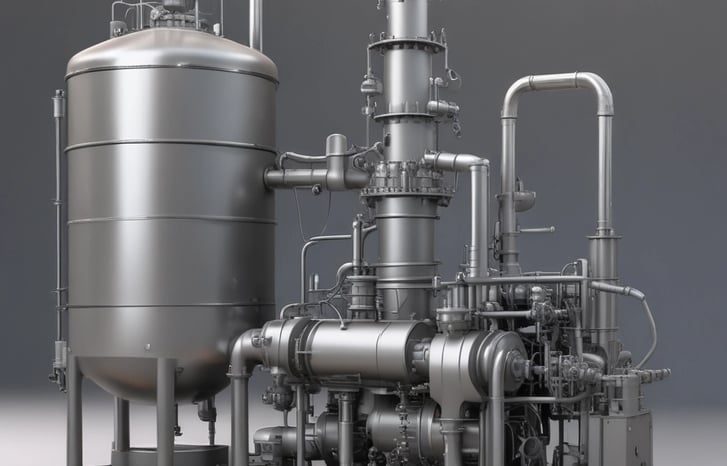Transforming Waste into Clean Energy: The Journey of waste into syngas and pyrolysis oil
how waste into syngas and pyrolysis oil technology works, turning plastic, biomass, and other waste into useful fuels. Learn the step-by-step process, key benefits, and why industries are adopting this sustainable solution to reduce waste and produce clean energy efficiently.
Veera Author
7/15/20255 min read


Understanding the Waste-to-Energy Process
The waste-to-energy process represents a transformative approach to managing refuse by converting it into functional energy sources. At its core, this technology aims to mitigate the environmental impact of waste while generating renewable energy in the form of syngas and pyrolysis oil. The method harnesses the inherent energy found within waste materials, especially plastics and biomass, and utilizes thermochemical conversion techniques such as gasification and pyrolysis to achieve this goal.
Gasification involves the partial oxidation of organic materials at high temperatures, leading to the production of syngas, a mixture of hydrogen, carbon monoxide, and other hydrocarbons. This syngas can be further treated and refined for various applications, including electricity generation, fuel production, and even as a raw material for chemical synthesis. The gasification process is highly efficient and produces fewer greenhouse gases compared to traditional incineration methods, making it an attractive option for sustainable waste management.
Conversely, pyrolysis is characterized by the thermal decomposition of organic material in the absence of oxygen. This process results in the creation of pyrolysis oil, carbon char, and syngas. The pyrolysis oil can serve as a renewable alternative to fossil fuels and can be utilized in various applications, including heating and electricity generation. By employing these thermochemical conversion processes, we can effectively divert waste from landfills, reduce greenhouse gas emissions, and enhance energy security.
Understanding the fundamentals of the waste-to-energy process is crucial as it highlights the potential benefits of these technologies. By converting waste into valuable energy products, syngas, and pyrolysis oil, we can address some of the pressing global challenges surrounding waste management and environmental sustainability.
Benefits of Converting Waste into Syngas and Pyrolysis Oil
The conversion of waste into syngas and pyrolysis oil presents a range of significant benefits that extend across environmental, economic, and social dimensions. One of the most immediate environmental advantages is the substantial reduction in landfill waste. By converting organic and non-organic materials through processes such as pyrolysis, we can significantly decrease the volume of waste that ultimately ends up in landfills, thus alleviating the burden on our waste management systems.
In addition to waste reduction, the transformation of waste into syngas and pyrolysis oil plays a critical role in mitigating greenhouse gas emissions. Traditional waste disposal methods, including landfill and incineration, release harmful gases such as methane and carbon dioxide. However, these advanced technologies enable waste to be converted into cleaner energy sources, which contribute to lower overall emissions. Furthermore, the recycling of carbon through the production of syngas allows for the capture and reuse of carbon in a way that benefits the energy cycle, helping to combat climate change.
From an economic perspective, converting waste into energy is advantageous for industries as it can lead to significant cost savings. Organizations can reduce their waste disposal expenses and instead utilize syngas and pyrolysis oil as alternative energy sources, which can be more affordable than fossil fuels in certain contexts. Moreover, the development of these technologies is driving job creation within the clean energy sector. As more facilities are established to facilitate the conversion processes, new employment opportunities arise, fortifying local economies and fostering a sustainable workforce.
The broader implications of these technologies contribute to a more sustainable and circular economy, where waste is seen not as a problem but as a resource. By investing in the transformation of waste into syngas and pyrolysis oil, we take strides towards a future that prioritizes sustainability, innovation, and economic resilience.
Real-World Applications and Success Stories
The conversion of waste into clean energy using syngas and pyrolysis oil has gained traction across various sectors, proving to be a sustainable solution in waste management and energy production. Industries such as manufacturing, agriculture, and municipal waste management have successfully adopted these technologies, yielding significant benefits.
In the manufacturing sector, companies are increasingly utilizing pyrolysis oil as a substitute for fossil fuels. For instance, in a notable project in Europe, a renowned plastic manufacturer implemented a pyrolysis plant that converts plastic waste into high-quality pyrolysis oil. This initiative not only reduced the company’s carbon footprint but also contributed to a circular economy by reusing plastic waste. The produced pyrolysis oil was used as a feedstock to produce new plastic products, exemplifying the symbiotic relationship between waste reduction and energy production.
Similarly, in the agricultural realm, syngas has been employed in powering farms and processing facilities. In an innovative project in the Midwest, a farm integrated a syngas system that converts organic waste, such as crop residues and manure, into energy. This system enabled the farm to become energy self-sufficient while providing an eco-friendly way to manage waste. Various agricultural stakeholders reported reduced operational costs and improved sustainability, highlighting the efficiency of utilizing syngas technology in achieving energy independence.
Municipal waste management also has witnessed transformative success stories. Cities across the globe are adopting pyrolysis technology to address substantial waste challenges. For example, a large urban center in Asia launched a pyrolysis project that shifted its waste management practices. By converting municipal solid waste into pyrolysis oil and syngas, the city drastically diminished landfilling and pollution concerns. This project has inspired other municipalities to explore waste-to-energy solutions, ensuring a cleaner environment while harnessing energy from disposed materials.
These success stories across various industries underscore the versatility and scalability of syngas and pyrolysis oil technologies, presenting compelling examples of how waste can be effectively transformed into valuable energy resources.
The Future of Waste-to-Energy Technologies
The landscape of waste-to-energy technologies is continuously evolving, driven by innovations aimed at enhancing efficiency and reducing costs. These advancements are pivotal in transforming waste into valuable resources, such as syngas and pyrolysis oil, thus contributing to a more sustainable energy future. Researchers and engineers are actively working on improving pyrolysis systems, focusing on the precision of thermal processing and optimizing operational parameters to maximize fuel recovery from waste materials. This not only increases the yield of clean energy but also diminishes the environmental impact associated with waste disposal.
Moreover, ongoing developments in cost-reduction strategies are essential for making waste-to-energy technologies more accessible. The integration of advanced sensors and artificial intelligence in waste management operations has the potential to streamline processes, thereby lowering operational expenses while improving overall efficiency. These technologies enable better sorting and handling of waste, ensuring that feedstock quality is maintained, which is crucial for effective energy conversion. As costs decline, the adoption rate of waste-to-energy solutions in both urban and rural settings can be expected to rise significantly.
Policy frameworks and community engagement also play a vital role in accelerating the adoption of waste-to-energy initiatives. Governments are beginning to recognize the necessity of promoting circular economy principles, thereby creating incentives for industries to invest in renewable energy technologies. Public awareness campaigns and educational programs can further highlight the intricate links between waste management, energy production, and environmental stewardship. The collaborative efforts of policymakers, researchers, and community advocates are essential in fostering an ecosystem where waste-to-energy technologies can thrive waste oil to diesel.
In conclusion, the future potential of waste-to-energy solutions is immense, hinging on technological advancements, strategic policies, and community involvement. By investing in these innovative approaches, society can significantly contribute to a greener future, making strides toward a sustainable and circular economy waste into syngas and pyrolysis oil.


